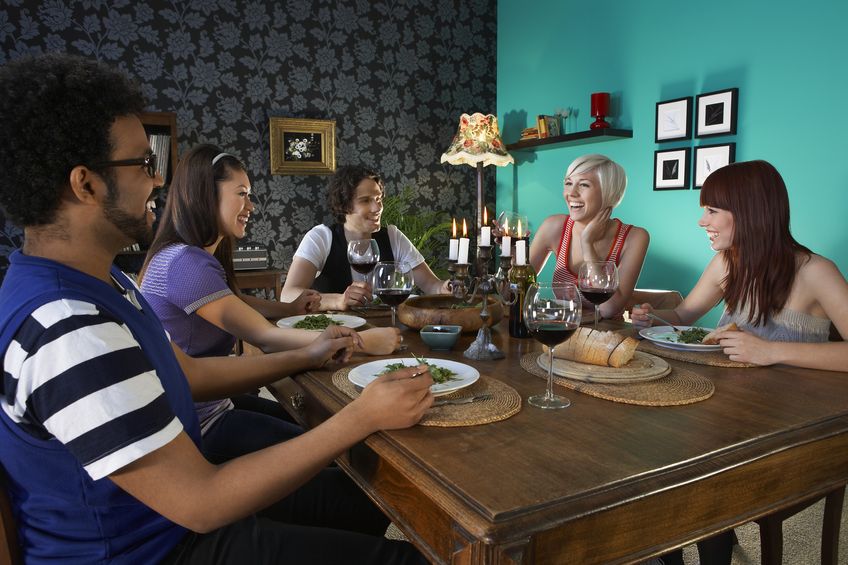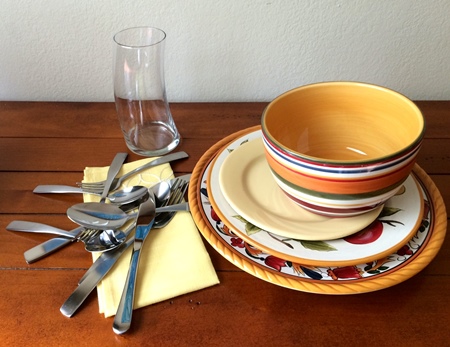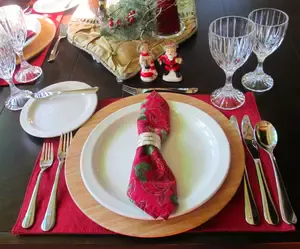The 3 Acts of Dining:
Enjoying Your Meal

As you read in my previous post, Approaching the Table, you want to play your part well in creating a gratifying experience when dining, socially or professionally. Good manners insist that we observe a number of civilities.
Your host has invited everyone to take a seat. When he places his napkin on his lap and you follow, the meal has begun. However, this doesn't mean that you should begin eating right away. Taking a drink would be appropriate, but wait for one more signal from your host before you begin eating. Your host may pick up his dining utensils or he may invite you simply to enjoy.
One goal of a pleasant dining experience is to stay under everyone’s radar: to have your manners go unnoticed. That’s right, your table manners should not be noticed. Rarely does anyone walk away from a table and whisper, “Wow, did you notice what great manners John has?”
Nevertheless, people are watching. Unfortunately, what might be noticed or silently contemplated is, “Wow, I can’t believe that she is putting that lipstick on right in the middle of the meal, and what will happen to her napkin!”
Civility is silent, but incredibly meaningful. Follow these guidelines as your silent partner while enjoying your meal, and others will enjoy your company.
Before Eating
As you sit down, notice the place setting in front of you. Particularly, how the forks, knives, and spoons are placed.
Only one fork and knife? Easy! You can expect a one-course or family-style meal. Two forks and two knives? You'll enjoy a salad and a main course. This same setting with a spoon on your right? Expect a bowl of soup as well.
Your place setting is the map of your meal. It sets an expectation of delicious food, while putting you at ease because you know the path you'll be taking to the end of the meal.
Before you pick up your fork to eat, you will have also chosen which dining style to use, Continental (2-step) or American (4-step). Unless of course you are eating another cultures’ specific food, in which case your host will be an example.
While Enjoying Your Meal
If you are shy or tend to have little to say, memorize 10 questions you might possibly ask as conversation starters. No one will ever know you aren't a natural conversationalist!
Your host has picked up his fork and your fellow diners have followed suit. Eating has begun, as well as conversations among everyone at the table.
It's time to be mindful to:
- Take small bites.
- Eat with your mouth closed.
- During the initial passing of food, wait until a dish reaches you before partaking. After the initial passing, ask for a dish to be passed to you instead of reaching over someone's plate to get it.
- Keep your hands completely away from your face or hair when dining.
- When talking, avoid accentuating a point with a utensil.
- Never lick your knife. (I only mention this because it has happened!)
- Once used, a utensil is never placed back on the table. Do not let a utensil hang off a plate.
- When a course is finished, place any utensils meant for that course on the plate, whether you used them or not.
- Keep conversation positive. If negativity creeps in, try and change the subject.
- At large gatherings, be sure you spend time talking with the person on your left and right side.
- Say positive things about the food and always be generous with “Thank you.” And “Please.”
- If you didn’t have a choice with what’s been ordered and you do not prefer the food, avoid any statement about it. You have diner’s discretion and can re-adjust the food on your plate such that no one would notice you’ve not eaten much (or any) of it.
- If asked if you like (or don’t like) the food, simply say, “I am enjoying my dinner! Thank you for asking.” or “Thank you! Everything’s lovely.”
- Sharing food is typically a No-No, especially at professional or gala affairs, but if someone asks you to share, do so before you begin eating. There are methods!
- Generally, keep your arms and elbows off the table, unless there is no food in front of you.
- Just as the host signals the beginning of the meal by placing his napkin in his lap, he signals the end of the meal by placing his napkin on the table.
Prepare for Act 3
The placing of napkins on the table at the end of the meal begins Act 3 - Leaving the Table.
But in preparation for this final act, reflect on the meal you just experienced. Did you enjoy the food? The company and conversation? The lovely table setting?
Take note of these things, as you will put them to use a little later . . .














